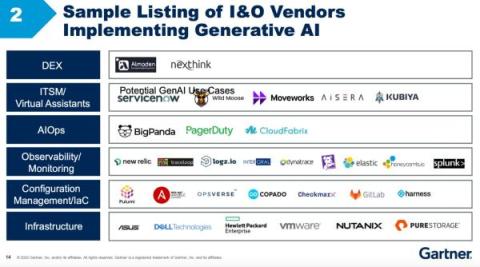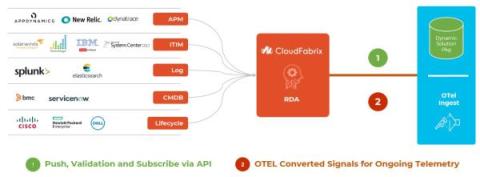Operations | Monitoring | ITSM | DevOps | Cloud
December 2023
Reflecting on my predictions for 2023 - Hits and Misses!
BigPanda's latest Unified Console features unveiled
In the fast-paced realm of incident management and response, the need to stay ahead is more vital than ever. In recognition of this, BigPanda has significantly enhanced the Unified Console, introducing a suite of new features designed to revolutionize incident handling. Let’s explore these transformative updates and how they can redefine your approach to incident management.
What is a multi-cloud management platform?
As an IT leader, you’re acutely aware of the struggles of juggling multiple cloud environments, from integration headaches to holistic incident management to monitoring multiple clouds at once. Seeking a more efficient multi-cloud management solution is crucial to alleviate these pressures and streamline your cloud operations.
Impressions from Gartner IOCS 2023
Gartner’s IT Infrastructure, Operations & Cloud Strategies Conference (IOCS) is an annual event that attracts ITOps, SRE, and DevOps leaders from around the world. As Gartner explains, IOCS “brings the world’s technology leaders together to hear top trends, find objective answers, and explore topic coverage in addition to best practices. Gain the insights and guidance to create an effective pathway to the future and network with your peers.”
Why monitoring your application is important
Effective monitoring and observability tools are critical for modern enterprises. Daily operations, digital transformation, moving to a cloud-native architecture, and an ever-evolving tech stack all require ITOps, DevOps, and SRE teams to monitor increasingly complex systems. So what happens if your applications suddenly cease to function? Every moment of downtime translates to lost income, decreased customer satisfaction, and harm to your company’s reputation.
Understanding ServiceNow Incident Management: A comprehensive guide
You’re focused on swiftly identifying, analyzing, and resolving disruptions in IT services. And you know all too well that correctly deploying and adopting incident management holds the key to delivering a more reliable and responsive IT environment for your applications and services. That’s why you’re using or are considering using ServiceNow’s incident management to ensure a structured and efficient approach to handling your IT service incidents.
Automated incident response in ITOps: Here's everything you need to know
If you’re like most IT leaders, you realize that automating repetitive, low-level incident response actions is key to unlocking enhanced workforce productivity, improved IT services, minimized downtime, better user experiences, cost savings, and the freedom to focus on innovation. Yet you don’t know where to start – or maybe aren’t sure of the best approach.
ScienceLogic Announces "Hollywood" Release of SL1 Platform, Introducing Advanced AI/ML & Automation Capabilities for AIOps
Getting started with IT operations automation
Tech companies face a daunting challenge: a staggering 90% of their IT teams are stuck doing mundane, repetitive tasks, leaving only 10% to focus on strategic innovation. Companies know that automation is the solution to these repetitive, low-level incident response actions; however, many need support to begin automating.
The ultimate guide to incident management KPIs and metrics
IT incident management aims to swiftly identify, address, and resolve IT disruptions to restore normal service operations. Tracking IT incident management key performance indicators (KPIs) is a vital step toward minimizing disruptions for customers and users. But there are several different KPI and metrics choices, and it’s not easy to identify the right ones that can drive meaningful improvements in incident management.
What is Mean Time to Resolution - and why does it matter?
Mean Time to Resolution (MTTR) is a key performance indicator (KPI) that measures the average duration needed to restore normal operation for an application, service or piece of infrastructure component. Your MTTR directly impacts customer satisfaction, so you must have a keen understanding how it influences the reliability and availability of your services and applications to make informed decisions, enable operational efficiency, and ensure a seamless customer experience.
5 Ways AIOps Monitoring Benefits EUC Environments
The adoption of AIOps monitoring technologies has been somewhat slower in EUC than many other areas of IT. The legacy VDI and DaaS vendor tools set expectations low for many. It is still relatively common for us to come across potential customers who are using legacy tools and manually exporting 6 months of data into an excel spreadsheet to try and work out average and peak usage of resources such as CPU to then manually calculate alert thresholds.
What is Mean Time to Detect (MTTD) - and why does it matter for ITOps?
Have you ever wondered about your IT team’s efficiency in detecting incidents? Your Mean Time to Detect (MTTD) is an incident management Key Performance Indicator (KPI) that reveals your productivity during the first stage of incident resolution and enables investigation into opportunities for improvement. ITOps and DevOps teams that can lower their MTTD can more quickly identify issues, minimize potential downtime, and maintain system reliability too.
Understanding IT event analytics: From basics to AIOps
A wise person once said, “What’s measured is what matters.” This couldn’t be more true than in the high-stakes world of IT operations, where the ability to swiftly measure, analyze, and respond to events is crucial for improving IT operational performance. This blog delves into defining IT event analytics, guiding you on getting started, showcasing real-world examples, and introducing essential methods to transforming your incident response strategy.
Incident tracking: How it works and why it matters for IT operations
Constantly juggling IT incidents can be exhausting as you try to track and resolve them before they escalate into disruptions. With each incident demanding prompt and precise attention, keeping up takes significant work. However, you can manage these challenges more efficiently and with less stress and less risk by optimizing your incident-tracking process.
Resolve Systems' AI Script Converter
Resolve's Automation Exchange
Discover the Untapped Power of AI in Predicting Correlations Before It's Too Late!
Your device pings, signaling another tech alert. Before you can address it, two more chime in. We all know the feeling. In today’s digital world, it’s easy to feel overwhelmed by the sheer number of notifications we receive. But what if there was a smarter way to handle them?






















